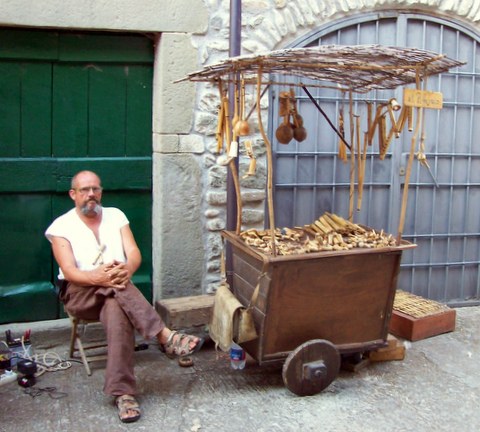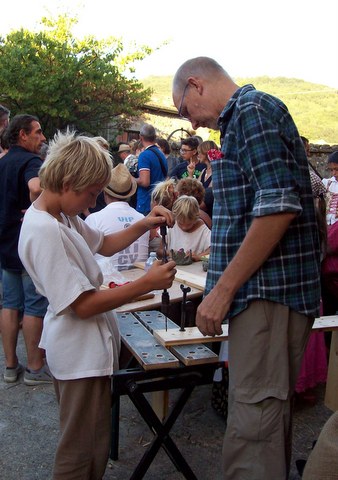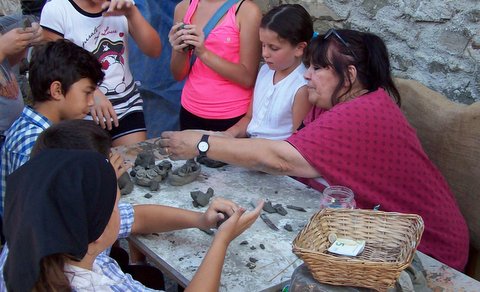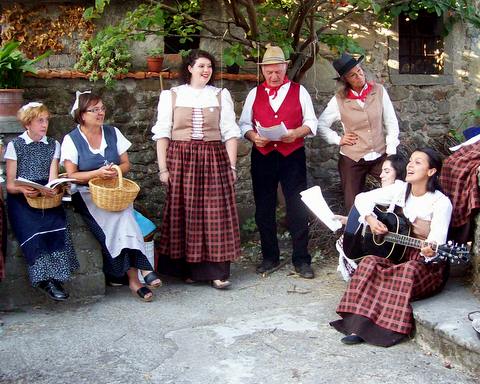Nella Piazza Del Paese Posted by Serena on Aug 17, 2017 in Uncategorized
Nell’antico borgo di Ponticello in Lunigiana il tempo si è fermato. Entriamo nella piazza del paese che brulica di attività intorno al vecchio pozzo.
Time has stopped in the ancient hamlet of Ponticello in Lunigiana. We enter the village square which is buzzing with activity around the old well.
Per prima cosa incontriamo il venditore di dolciumi: il banco è una festa di colori, gusti e profumi. Accanto a lui la merciaia sta creando un bellissimo pizzo all’uncinetto, mentre il marito chiacchiera col pifferaio ungherese al banco accanto.
First we meet the sweet seller: his stall is a feast of colours, flavours and smells. Next to him the haberdasher is creating a beautiful piece of crocheted lace-work, while her husband is chatting with the Hungarian piper at the next stall.
Davanti a loro ci sono le due tessitrici col loro telaio verticale su cui tessono scialli e sciarpe di calda lana rustica. La gente guarda affascinata dalla complessità di tutti quei fili. Ogni tanto arrivano nuvole di fumo dal braciere dove gli artigiani stanno sciogliendo la cera d’api per fare le candele, sia quelle lunghe tradizionali, che quelle nelle formine che piacciono tanto ai ragazzini.
Opposite them there are two weavers with the vertical loom on which they’re weaving shawls and scarves made of warm rustic wool. Every now and then clouds of smoke arrive from the brazier where the artisans are melting beeswax to make candles, both the long traditional type and those made in the moulds, which the children really love.
Geoff il falegname insegna ai bambini ad usare gli attrezzi del mestiere. Insieme stanno costruendo un acquario di legno che poi riempiono di creature marine fatte con la creta da Giovanna la ceramista e i suoi giovani apprendisti.
Geoff the carpenter is teaching children how to use the tools of his trade. They’re building a wooden aquarium which they’ll then fill with sea creatures made out of clay by Giovanna the ceramist and her young apprentices.
Sull’altro lato della piazza, accanto al vecchio pozzo, alcune donne impastano il pane, mentre i bambini aiutano a fare i biscotti da cuocere nei testi che hanno messo a scaldare sul fuoco lì accanto. Dopo pochi minuti i biscotti sono pronti, profumati e croccanti, e i bambini li offrono orgogliosi a tutti i presenti.
On the opposite side of the piazza, next to the old well, some women are kneading dough, whilst the children are helping make biscuits to cook in the iron skillets which they’ve put on the nearby fire to heat up. After a few minutes the biscuits are ready, they’re fragrant and crunchy, and children proudly offer them to all present.
Arrivano i musicanti a rallegrare i lavoratori nelle loro fatiche, mentre a portare un po’ di sollievo dal caldo ci pensa l’Ape Car trasformata in gelateria! Un tocco di modernità in questa scena senza tempo nel bellissimo borgo di Ponticello, che tutti gli anni, ad agosto, per pochi giorni torna a vivere il suo splendido passato.
The musicians arrive to cheer up the workers in their labours, while the Ape Car turned into an ice cream shop brings a bit of relief from the heat! A touch of modernity in this timeless scene in the beautiful hamlet of Ponticello, which every year, in August, for a few days lives its splendid past once more.

Build vocabulary, practice pronunciation, and more with Transparent Language Online. Available anytime, anywhere, on any device.









Comments:
Charlie DeWeese:
. . .cuocere nei testi. . .
Non conosco questa parola “testi” per significare “skillets”. Può spiegarmelo?
Serena:
@Charlie DeWeese Salve Charlie!
Testi è la parola usata qui in Lunigiana per questo tipo di teglie con coperchio, che vengono usati per cucinare sopra al fuoco. Non sono usati da nessuna altra parte i Italia.
Saluti da Serena
Nancy Holtz:
I already subscribe and I love your blog and I send it to the other members of our informal Italian class. It is extremely useful as I learn so much vocabulary from it. Mille grazie
Serena:
@Nancy Holtz Grazie a te Nancy!
paolo minotto:
Ciao Serena,
La frase”…mentre a portare un po’ di sollievo dal caldo ci pensa l’Ape Car trasformata in gelateria! ”
Puoi elaborare sul significato di “ci pensa” in questo contesto?
Grazie.
Geoff:
@paolo minotto Blog about the verb pensarci coming soon!!! 🙂
Patricia Sandler:
Ho la voglia di vedere questo paesino medievale. E` un peccato pero’ che solo l’estate sia piena di gente che gode l’esercitarsi dei mestieri di una volta.
Charlie DeWeese:
Un’altra traduzione, forse: “think about the Ape Car . . .”
Per quelli che non conoscono l’Ape Car, si può vederlo su Google. È un piccolo camioncino con tre ruote, adatto ai vicoli stretti, e molto comune in italia.
Geoff:
@Charlie DeWeese Ciao Charlie.
Hai scritto: “think about the Ape Car . . .”. Mi dispiace, ma questa traduzione è sbagliata.
Ci pensa l’ape car voul dire: ‘the Ape Car will sort it out’, dal verbo pensarci = ‘to take care of something/sort something out’.
Intanto, Ape è il nome del veicolo, così come Punto, Cinquecento, Vespa, Panda, Ypsilon e così via. Il nome non va tradotto.
Saluti da Geoff 🙂
Charlie DeWeese:
l’Ape Car si è chiamato dall’insetto che fa il miele; non dalla scimmia antropomorfa!